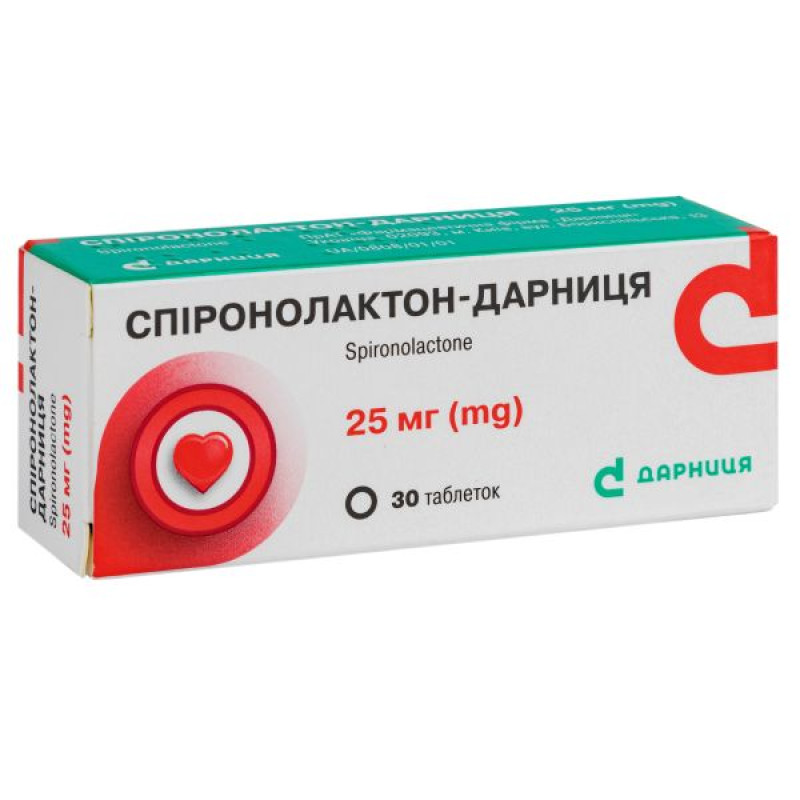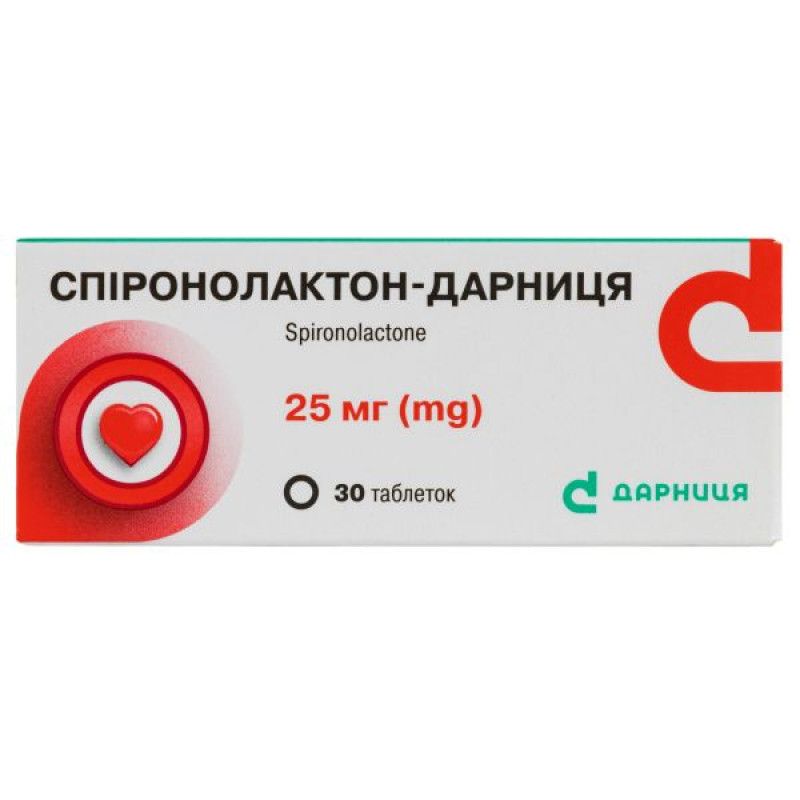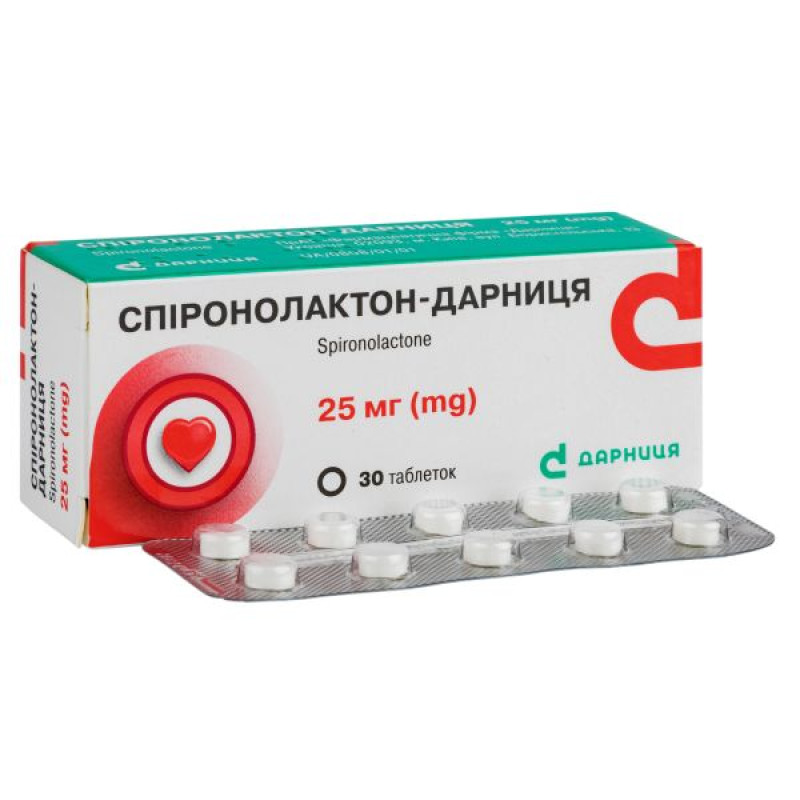Spironolactone-Darnitsa tablets 25 mg No. 30

Instructions Spironolactone-Darnitsa tablets 25 mg No. 30
Composition
active ingredient: spironolactone;
1 tablet contains spironolactone 25 mg;
Excipients: potato starch, lactose monohydrate, povidone, calcium stearate.
Dosage form
Pills.
Main physicochemical properties: flat-cylindrical tablets with a bevel, white or white with a creamy tint.
Pharmacotherapeutic group
Potassium-sparing diuretics. Aldosterone antagonists. Spironolactone. ATC code C03D A01.
Pharmacological properties
Pharmacodynamics.
The active substance of the drug - spironolactone - is a competitive antagonist of aldosterone, which acts on the distal tubules of the kidneys. Due to the blockade of aldosterone, it suppresses the retention of water and Na+ ions and promotes the retention of K+ ions, which not only increases the excretion of Na+ and Cl− ions and reduces the excretion of K+ ions with urine, but also reduces the excretion of H+ ions. As a result, the diuretic effect also has a hypotensive effect.
Pharmacokinetics.
After oral administration, the drug is rapidly and completely absorbed from the gastrointestinal tract. Bioavailability is 92–99%, and may be slightly increased when taken with food.
The maximum concentration of spironolactone in the blood serum is observed after 2.6 hours and is 80 ng/ml. Binding to plasma proteins is about 90%. The half-life is 1.3 hours.
Spironolactone is metabolized in the liver. Its active metabolites are 7α-thiomethylspironolactone and canrenone. The antialdosterone effect is determined by canrenone, which accounts for approximately 50% of all spironolactone metabolites. Peak plasma concentrations and time to reach them are: for 7α-thiomethylspironolactone – 391 ng/ml and 3.2 hours, for canrenone – 181 ng/ml and 4.3 hours. The half-life is 13.8 hours and 16.5 hours, respectively. Spironolactone and its metabolites penetrate the placenta and into breast milk.
It is excreted from the body in the form of metabolites mainly by renal excretion, a small part is excreted with feces. Spironolactone is characterized by a cumulative effect.
Indication
Primary hyperaldosteronism.
Congestive heart failure when other diuretics are ineffective or intolerant, or when their effectiveness needs to be increased.
Essential hypertension, mainly in the presence of hypokalemia, usually in combination with other antihypertensive drugs.
Cirrhosis of the liver accompanied by edema and/or ascites.
Edema caused by nephrotic syndrome.
Hypokalemia – if other therapy is not possible.
Prevention of hypokalemia in patients receiving cardiac glycosides when other therapies are considered inappropriate or inappropriate.
Contraindication
Hypersensitivity to the active substance or to other components of the medicinal product.
Acute renal failure, severe impairment of nitrogen-excreting renal function (glomerular filtration rate < 10 ml/min), anuria.
Hyperkalemia, hyponatremia.
Addison's disease.
Concomitant use with potassium-sparing diuretics and potassium preparations due to the possibility of developing hyperkalemia.
Interaction with other medicinal products and other types of interactions
When spironolactone is used simultaneously with other drugs, it is possible:
with antihypertensive drugs (especially ganglioblockers, nicardipine, nimodipine) - excessive decrease in blood pressure; with simultaneous use, the dose of antihypertensive drugs should be reduced with subsequent correction if necessary. Since angiotensin-converting enzyme (ACE) inhibitors reduce aldosterone production, drugs of this group should not be used concomitantly with spironolactone on a permanent basis, especially in patients with impaired renal function;
with ammonium chloride, cholestyramine - increased risk of developing hyperkalemia and hyperchloremic metabolic acidosis;
with potassium-sparing diuretics, potassium preparations, ACE inhibitors, angiotensin II receptor blockers, aldosterone receptor blockers, anticholinesterase agents, tacrolimus, cyclosporine - increased risk of hyperkalemia; simultaneous use with potassium-sparing diuretics and potassium preparations is contraindicated due to the possibility of hyperkalemia;
with other diuretics – increased diuretic effect;
with nonsteroidal anti-inflammatory drugs - increased risk of hyperkalemia and renal failure with a concomitant decrease in the diuretic, natriuretic and antihypertensive effects of spironolactone; with simultaneous use with acetylsalicylic acid, prostaglandin synthesis is also inhibited, with antipyrine - its metabolism in the liver is enhanced;
with glucocorticosteroids, adrenocorticotropic hormone (ACTH) – increased diuretic, natriuretic effects of spironolactone and paradoxical increased potassium excretion;
with α- and β-adrenomimetics, carbenoxolone – weakening of the effect of spironolactone;
with barbiturates, narcotic drugs, ethanol – the occurrence of orthostatic hypotension;
with terfenadine - increased risk of ventricular arrhythmia due to hypokalemia and imbalance of other electrolytes;
with carbamazepine – increased risk of hyponatremia;
with digoxin – increased risk of glycoside intoxication due to prolongation of its half-life;
with lithium preparations - increased risk of intoxication due to decreased renal clearance of lithium; these drugs should not be used simultaneously;
with indirect anticoagulants (coumarin derivatives), mitotane, pressor amines (epinephrine), cardiac glycosides - weakening of the action of the latter;
with heparin, low molecular weight heparin – the occurrence of severe hyperkalemia;
with triptorelin, buserelin, gonadorelin - increased action of the latter;
with the combination of trimethoprim/sulfamethoxazole (an antibiotic, the so-called co-trimoxazole) – the occurrence of clinically significant hyperkalemia;
with immunosuppressants, cyclosporine and tacrolimus - increased risk of developing hyperkalemia caused by spironolactone;
with cholestyramine, ammonium chloride - increased risk of developing hyperkalemia and hyperchloremic metabolic acidosis;
with nitroglycerin, other nitrates or vasodilators - enhancement of the antihypertensive effect of spironolactone;
with pressor amines (norepinephrine) - reduced vascular responses to norepinephrine. For this reason, caution should be exercised when performing local or general anesthesia in patients taking spironolactone;
with antipyrine – acceleration of antipyrine metabolism;
with carbenoxolone - the occurrence of sodium retention in the body and, as a result, a decrease in the effectiveness of spironolactone. The simultaneous use of carbenoxolone and spironolactone should be avoided;
with abiraterone – when used concomitantly, spironolactone binds to the androgen receptor and may increase prostate-specific antigen (PSA) levels in prostate cancer patients treated with abiraterone. Use with abiraterone is not recommended.
Spironolactone may enhance the effects of GnRH (gonadotropin-releasing hormone) analogues: triptorelin, buserelin, gonadorelin.
Application features
The use of the drug, especially in patients with impaired renal function, may cause a transient increase in blood urea nitrogen and hyperkalemia, which may lead to the development of cardiac arrhythmias and reversible hyperchloremic metabolic acidosis. The drug should be used with caution in patients with impaired renal function, liver function and elderly patients. Plasma electrolyte levels and renal function should be periodically determined. In the event of hyperkalemia, treatment with spironolactone should be discontinued.
The drug should be used with caution in patients with existing diseases that may predispose to the development of acidosis and/or hyperkalemia.
Concomitant use of spironolactone with drugs that cause hyperkalemia (e.g. other potassium-sparing diuretics, ACE inhibitors, angiotensin II receptor antagonists, aldosterone blockers, heparin, low molecular weight heparin, potassium supplements, a potassium-rich diet, use of salt substitutes containing potassium) may lead to the development of severe hyperkalemia.
Hyperkalemia can be fatal. It is critical to monitor and correct potassium levels in patients with severe heart failure receiving spironolactone. The drug should not be used with other potassium-sparing diuretics. Potassium supplements are contraindicated in patients with serum potassium levels above 3.5 mEq/L. The recommended frequency of potassium and creatinine levels is one week after initiation or dose increase of spironolactone, monthly for the first 3 months, then quarterly for the first year, and then every 6 months. If serum potassium levels exceed 5 mEq/L or creatinine levels exceed 4 mg/dL, spironolactone should be temporarily or permanently discontinued.
The drug should be used with caution in patients with diabetes, especially in the presence of diabetic nephropathy.
Spironolactone therapy may interfere with the determination of cortisol, epinephrine, and digoxin concentrations (by radioimmunoassays).
Prolonged, unjustified use of the drug should be avoided, since, according to studies, prolonged use of spironolactone in animals at maximum doses contributed to the development of carcinoma and myeloid leukemia.
It is forbidden to drink alcoholic beverages while using the medicine.
Spironolactone-Darnitsa contains lactose, therefore patients with rare hereditary forms of galactose intolerance, lactase deficiency or glucose-galactose malabsorption syndrome should not use the medicine.
Spironolactone should be used with extreme caution in patients with porphyria, as many drugs provoke exacerbation of porphyria.
Use during pregnancy or breastfeeding
The drug is contraindicated during pregnancy or breastfeeding.
Ability to influence reaction speed when driving vehicles or other mechanisms
During the initial period of taking the drug, the duration of which is individual, driving or operating other mechanisms is contraindicated.
Method of administration and doses
The drug is to be used orally by adults and children. The daily dose of the drug should be taken in 1 or 2 divided doses after meals. The daily dose should be taken in 1 or 2 divided doses or the first dose of the drug in the case of twice daily use is recommended in the morning.
The duration of the treatment course is individual, in some cases it can reach several years, while it is necessary to use the drug in the lowest effective daily dose, subject to constant monitoring of the electrolyte composition of the blood serum and kidney function indicators.
Adults.
Primary hyperaldosteronism.
When preparing for surgery, the drug should be used at a dose of 100-400 mg per day.
If surgical treatment is not possible, spironolactone can be used long-term as maintenance therapy in the lowest effective dose, which is determined individually.
In this case, the initial dose can be reduced every 14 days until the minimum effective dose is reached. With long-term treatment, it is recommended to use the drug in combination with other diuretics to reduce side effects.
Congestive heart failure, edema due to nephrotic syndrome.
The drug should be used at an initial dose of 100 mg per day in 1 or 2 doses. The daily dose can also vary from 25 to 200 mg.
When prescribing higher doses, the drug can be used in combination with other diuretics that act in more proximal parts of the renal tubules. In this case, the dose of spironolactone should be adjusted.
Essential hypertension.
The drug should be used in an initial dose of 50-100 mg per day in 1 or 2 doses in combination with other antihypertensive drugs. Treatment should be continued for at least 2 weeks, since by the end of this period the maximum antihypertensive effect is achieved. Further dose adjustment is individual depending on the achieved effect.
Cirrhosis of the liver accompanied by edema or ascites.
If the ratio of Na+/K+ in the urine is greater than 1, the drug should be used at an initial dose of 100 mg per day. The maximum daily dose is 100 mg/day. If this ratio is less than 1, the drug should be used at a dose of 200 mg per day, with a maximum daily dose of 400 mg/day.
Hypokalemia.
The drug should be used at a dose of 25-100 mg per day in patients who do not receive enough potassium supplements or other methods of potassium replacement therapy.
For children.
The drug should be used at a dose of 1-3 mg/kg body weight per day in 1 or 2 doses. For maintenance therapy in combination with other diuretics, the daily dose is 1-2 mg/kg body weight.
If it is necessary to use the medicine in children under 3 years of age, the tablet should be crushed, dissolved and given to the child as a suspension.
Elderly patients.
The drug is recommended to be used in lower doses with subsequent gradual increase until the maximum effect is achieved. It should be taken into account that this category of patients has hepatic and renal disorders, which may affect the metabolism and excretion of the drug.
Children
The drug is used in pediatric practice as prescribed by a doctor.
Overdose
Symptoms: drowsiness/lethargy, confusion, electrolyte disturbances.
Treatment: symptomatic therapy. It is necessary to maintain water-electrolyte and acid-base balances: use potassium-depleting diuretics, parenterally administer glucose with insulin, in difficult cases - hemodialysis. There is no specific antidote.
Adverse reactions
From the cardiovascular system: arterial hypotension, arrhythmia (in patients with renal failure and those receiving potassium preparations), vasculitis.
From the blood and lymphatic system: leukopenia (including agranulocytosis), thrombocytopenia, megaloblastic or aplastic anemia, eosinophilia.
From the nervous system and psyche: headache, drowsiness, dizziness, ataxia, paralysis, paraplegia, lethargy, inhibition, confusion.
Respiratory, thoracic and mediastinal disorders: change in voice timbre.
On the part of the digestive tract: nausea, vomiting, decreased appetite, abdominal and stomach pain, diarrhea, constipation, intestinal colic, gastritis, gastric and duodenal ulcers, gastric bleeding.
From the hepatobiliary system: hepatitis, liver dysfunction.
From the urinary system: acute renal failure.
Musculoskeletal and connective tissue disorders: osteomalacia, muscle spasm, muscle cramps of the lower extremities.
Metabolism and metabolism: hyperkalemia, hyponatremia, hypercreatininemia, increased blood urea level, hyperuricemia, porphyria, metabolic hyperchloremic acidosis or alkalosis, dehydration.
From the reproductive system and mammary glands: decreased libido, erectile dysfunction, gynecomastia, menstrual irregularities, dysmenorrhea, amenorrhea, metrorrhagia during menopause, swelling and pain of the mammary glands in women, infertility (in case of using high doses - 450 mg per day), benign tumors of the mammary glands.
Immune system, skin and subcutaneous tissue disorders: hypersensitivity reactions, including: rash, itching, urticaria, drug fever; hypertrichosis, alopecia, lupus-like syndrome, hyperemia, erythema multiforme, eczema, Stevens-Johnson syndrome.
General: asthenia, fatigue.
Expiration date
3 years.
Storage conditions
Store in the original packaging at a temperature not exceeding 25 °C.
Keep out of reach of children.
Packaging
10 tablets in a contour blister pack; 3 contour blister packs in a pack.
Vacation category
According to the recipe.
Producer
PrJSC "Pharmaceutical Company "Darnitsa".
Location of the manufacturer and its business address
Ukraine, 02093, Kyiv, Boryspilska St., 13.
There are no reviews for this product.
There are no reviews for this product, be the first to leave your review.
No questions about this product, be the first and ask your question.





